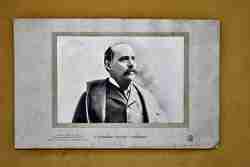Toronto. Have you ever heard of a”chemigraph”? It is an engraving made on a metal (zinc) plate using chemicals instead of photography. The word originated in German combining chem- + -graph The image can be reproduced as a platinum print.
The process maybe somewhat uncommon as there is little reference to it on the internet.
Past president, sports photographer, and author Les Jones sent a note the other day about some finds from the USA. He says in part, “[This is] a photo marked “A permanent ‘platino’ chemigraph”. Photo by Strauss, St, Louis. Negative on Cramer Isochromatic Plate. Reproduction from print on “Aristo-Platino”paper [see image at left].
“Never heard of this particular type although Celio Barreto [PHSC programmes] has an article on The Platinotype Process so he might have input.
“A chemigraph is an engraving made by the process of chemigraphy, which uses chemical actions to etch designs onto a metal plate, often zinc, without photography. So maybe mine is a copy of a platinum print made by the chemigraph process??
“FYI: in 2006: A photograph printed in platinum and then modified with the gum bichromate process, has sold for nearly $3 million at Sotheby’s.
“[It’s] an image of a moonrise over a lake, printed in platinum and then modified with the gum bichromate process, has sold for nearly $3 million at Sotheby’s, New York, setting a new price record for any art photograph.
“As the chemist and photography expert Mike Ware reports, the record-breaking print, entitled The Pond – Moonlight, dates from 1904 and is the work of the American artist Edward Steichen (1879-1973).”
If you have further details on the rare process, drop me a line at info@phsc.ca.









